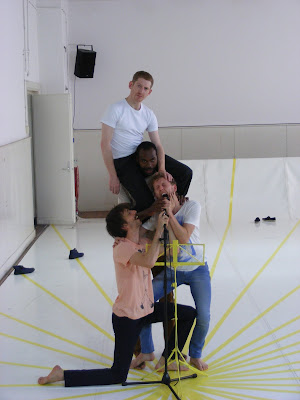DRAMATURGY AS A MODE OF LOOKING
A WORKING METHOD TO PERCEIVE MOVEMENT
Based on starting to write this blog, I feel the urge to frame my background as a dramaturge a bit more. Becoming an artistic co-creator in dance making came very natural to me. Asking relevant & clear formulated questions is an artform in itself, especially in comparison to round-up singular answers. And this comes down 'handy' when being a practicing dramaturge like me. And my awareness grew over the years how my work is strongly intertwined in the way I experience life. And because it is not the most common job, I will exemplify it below from my personal trajectory.
 As a dramaturge I work with choreographers who are doing research or preparing/rehearsing a dance performance to present in the theatre, a festival, somewhere on location or for a dance film. In general you could explain a dramaturge as the guardian keeper of the original ideas for the work of art, the first viewer (audience) down the studio, a research partner and intellectual chameleon who understands where the necessity of a dance piece is coming from. And it was exactly the fact that dance was talking without words that spoke to me. It made so much visible that reaches further than spoken words. And to find a spoken language to start a dialogue around it really felt like a creation. Well, this is how my practice gradually got formed for the most part (illustration of a rehearsal of Flatland by Mor Shani, picture by me).
As a dramaturge I work with choreographers who are doing research or preparing/rehearsing a dance performance to present in the theatre, a festival, somewhere on location or for a dance film. In general you could explain a dramaturge as the guardian keeper of the original ideas for the work of art, the first viewer (audience) down the studio, a research partner and intellectual chameleon who understands where the necessity of a dance piece is coming from. And it was exactly the fact that dance was talking without words that spoke to me. It made so much visible that reaches further than spoken words. And to find a spoken language to start a dialogue around it really felt like a creation. Well, this is how my practice gradually got formed for the most part (illustration of a rehearsal of Flatland by Mor Shani, picture by me).
 As a dramaturge I work with choreographers who are doing research or preparing/rehearsing a dance performance to present in the theatre, a festival, somewhere on location or for a dance film. In general you could explain a dramaturge as the guardian keeper of the original ideas for the work of art, the first viewer (audience) down the studio, a research partner and intellectual chameleon who understands where the necessity of a dance piece is coming from. And it was exactly the fact that dance was talking without words that spoke to me. It made so much visible that reaches further than spoken words. And to find a spoken language to start a dialogue around it really felt like a creation. Well, this is how my practice gradually got formed for the most part (illustration of a rehearsal of Flatland by Mor Shani, picture by me).
As a dramaturge I work with choreographers who are doing research or preparing/rehearsing a dance performance to present in the theatre, a festival, somewhere on location or for a dance film. In general you could explain a dramaturge as the guardian keeper of the original ideas for the work of art, the first viewer (audience) down the studio, a research partner and intellectual chameleon who understands where the necessity of a dance piece is coming from. And it was exactly the fact that dance was talking without words that spoke to me. It made so much visible that reaches further than spoken words. And to find a spoken language to start a dialogue around it really felt like a creation. Well, this is how my practice gradually got formed for the most part (illustration of a rehearsal of Flatland by Mor Shani, picture by me).In the dance field the role of a dramaturge can differ either by the nature of dialogue with the choreographer or the underlying demands of the creation to be. To clarify beforehand, the dramaturge is in no way a substitute for a failing artist. Coaching techniques are required to be able to connect to an artist, but never to compensate any so-called missing talent. Both work equally together; they function in separate dimensions of the creative process. To illustrate, a dramaturge caries responsibility for constructing a performative language by moving bodies in a theatrical setting only in terms of audience perception & engagement. So a dramaturge has no ownership in the creative solutions a choreographer has to tackle in his or her work of art. The dramaturge can therefore be called a mediator between what the created art work is communicating & how an audience can understand this performance.
Explaining dramaturgy brings an insight in the way I connect with my surrounding. Communication here comes from questioning the potential of any situation by seeing all that is not there yet. And it is urgent to me to make that visible by research & language, or in this case by writing down. This specific mode of looking (theoretic term borrowed from Prof. Maaike Bleeker) is essential to the way I make sense of the world, human interaction, art & life.

Comments
Post a Comment